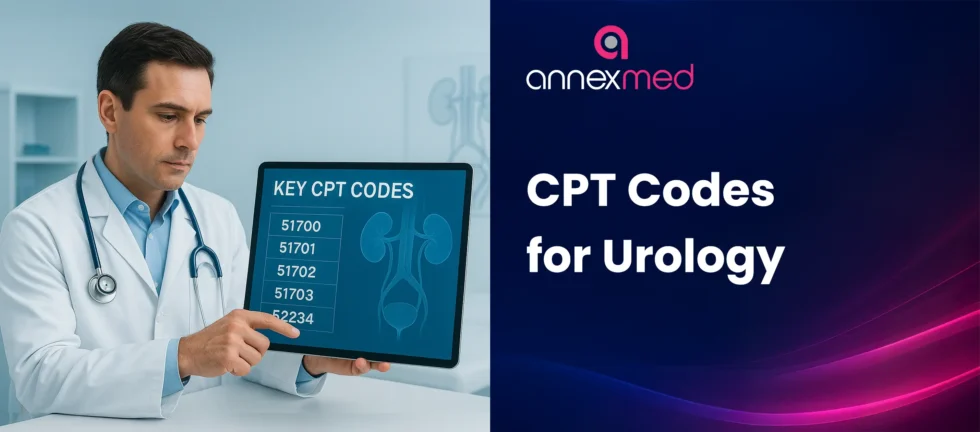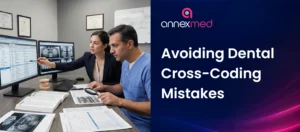Accurate CPT coding is essential in urology to ensure proper reimbursement, maintain compliance, and reduce claim denials. Urology includes a wide range of procedures, from diagnostic cystoscopies to complex nephrectomies. Errors in coding or documentation can lead to delayed payments or payer audits.
Coding in urology is nuanced because many procedures involve multiple steps, bundled services, and payer-specific rules. Even small documentation gaps, such as missing laterality or procedural details, can trigger denials.
This blog provides a concise overview of commonly used urology CPT codes, key billing and documentation tips, and quick-reference tables. Coders, billers, and urology providers can use these insights to streamline workflows, reduce errors, and improve revenue cycle efficiency.
Table of Contents
Essential CPT Codes for Urology Procedures
Urology procedures cover a variety of diagnostic, therapeutic, and surgical services. Having a quick-reference map of commonly used CPT codes can help coders and providers submit accurate claims efficiently.
| Procedure Type | Common CPT Codes | Notes |
| Diagnostic Cystoscopy | 52000, 52001, 52005, 52010 | Office or hospital; document findings and instruments |
| Therapeutic/Bladder Procedures | 52234–52240 | Tumor fulguration, resection, or dilation; check bundling rules |
| Ureteroscopy & Lithotripsy | 52351–52356 | Stent placement may be included in some codes |
| Prostate Procedures | 55700 (biopsy), 52601 (TURP) | Note approach, number of cores, clinical indication |
| Renal Surgery | 50220–50240, 50230 | Partial vs radical nephrectomy; document laterality and extent |
| Ambulatory/Office Procedures | 55250 (vasectomy) | Global period may apply; check payer rules |
This table provides a quick overview of codes most frequently used in urology. Correct code selection, along with thorough documentation, is essential to prevent denials and ensure timely reimbursement.
Cystoscopy and Ureteroscopy CPT Codes
Diagnostic Codes
- 52000 – Cystourethroscopy (diagnostic; basic evaluation of the bladder and urethra).
- 52001 – Cystourethroscopy with irrigation and/or clot evacuation (adds simple therapeutic step).
- 52005 – Cystourethroscopy with removal of foreign body or bladder stone.
Therapeutic Codes
- 52204 – Cystourethroscopy with biopsy (tumor or lesion evaluation).
- 52234–52240 – Cystourethroscopy with fulguration or laser destruction of bladder lesions or tumors.
Ureteroscopy and Stone Removal
- 52310 – Ureteral catheterization during cystoscopy or ureteroscopy.
- 52320 – Ureteroscopy with removal of ureteral stone without lithotripsy.
- 52351–52356 – Cystourethroscopy with lithotripsy and stone fragment removal (most frequently used).
Prostate Procedure CPT Codes
Diagnostic Codes
- 55700 – Needle biopsy of prostate (any approach).
- 55706 – Repeat prostate biopsy.
- 76872 – Transrectal ultrasound (TRUS) guidance for biopsy.
Treatment Codes
- 52601 – TURP for BPH (transurethral resection; commonly billed for symptomatic relief).
- 52648 – Laser vaporization of the prostate (e.g., Greenlight PVP).
- 55866 – Laparoscopic or robot-assisted prostatectomy.
- 55812 / 55815 – Prostatectomy with regional lymph node dissection for advanced cases.
Urinary Stone Procedures CPT Codes
Extracorporeal Shock Wave Lithotripsy (ESWL)
- 50590 – ESWL for renal or ureteral stones.
Ureteroscopy and Endoscopic Stone Removal
- 52352 – Cystourethroscopy with ureteroscopy and/or pyeloscopy; without lithotripsy.
- 52353 – Cystourethroscopy with lithotripsy and stone fragment removal (most frequently used).
- 52355 – Ureteroscopy with laser fragmentation only.
Percutaneous Nephrolithotomy (PCNL)
- 50080 / 50081 – PCNL, may require co-surgeon or assistant surgeon modifiers.
Renal and Open Urologic Surgery CPT Codes
Partial Nephrectomy
- 50220–50240 – Partial nephrectomy (open or laparoscopic; extent determines code).
- 50240 – Segmental resection of kidney (more complex partial nephrectomy).
Radical Nephrectomy
- 50230 – Radical nephrectomy (entire kidney removal).
Additional/Reconstructive Procedures
- Lymph node dissection or adrenalectomy as applicable.
- 50545 – Laparoscopic pyeloplasty for reconstructive cases.
Ambulatory Urology and Male Genital CPT Codes
Common Outpatient Codes
- 55250 – Vasectomy.
- 54150 / 54160 – Circumcision, newborn or pediatric (codes vary by method and age).
- 55000 – Drainage of testicular abscess.
- Hydrocelectomy codes (office or minor procedure).
Procedure Notes
- Minor procedures may have a global period; document anesthesia type, complexity, and approach.
- Include procedure-specific details to justify code selection.
Modifiers
Using the correct modifiers is essential for urology CPT coding to avoid denials and ensure proper reimbursement.
- RT / LT – Indicates laterality for kidneys, ureters, and testes. For example, a partial nephrectomy on the right kidney should include RT.
- 50 – Bilateral procedures, such as bilateral vasectomy or kidney procedures. Some payers require separate documentation to support this.
- 59 / XS – Denotes a distinct procedural service when a CPT code might otherwise be considered bundled. For instance, cystoureteroscopy with lithotripsy (52353) and a separate ureteral stent placement might require 59 if payer rules allow.
- 58, 78, 79 – Used for staged, planned, or return-to-OR procedures. Example: placing a stent after initial stone removal.
Additional Modifiers for Special Scenarios
- 22 – Increased procedural service; used when a procedure is more complex or time-consuming than usual.
- 52 – Reduced services; for partial or limited interventions.
- 26 / TC – Professional or technical component for imaging or lab guidance, such as TRUS (76872).
Always check payer-specific guidance, as modifier rules can vary and impact reimbursement.
Coding & Billing Tips
Accurate coding and billing are essential to maximize reimbursement and prevent denials for urology procedures. Follow these strategies to stay compliant and efficient:
- Match Codes to Documentation
Ensure every CPT code is fully supported by the provider’s notes. Include procedure details such as approach, laterality, number of specimens, or stones removed. For example, the number of cores in a prostate biopsy justifies 55700, and specifying stone fragmentation confirms 52353. - Verify Bundling and NCCI Edits
Many urology procedures include minor adjunct services. Review CPT descriptors and NCCI edits to avoid unbundling claims for services already included in the base code. - Apply the Correct Modifiers
Use modifiers appropriately: RT/LT for laterality, 50 for bilateral procedures, 59/XS for distinct services, and 58/78/79 for staged or return-to-OR procedures. - Prior Authorization Awareness
High-cost or complex procedures, such as lithotripsy, PCNL, or prostate surgery, may require prior authorization. Confirm payer requirements before scheduling to prevent claim delays. - Audit for Common Errors
Check for missing laterality, duplicated procedures, or incomplete documentation for therapeutic interventions.
Quick Checklist for Clean Claims
Right code?
Right modifier?
Documentation complete?
Bundling verified?
Prior authorization obtained if required?
Accurate coding for urology procedures helps ensure claims are processed smoothly and payments are received on time. Understanding the key codes for common urology procedures, along with careful documentation and correct use of modifiers, reduces errors and avoids unnecessary claim delays.Partnering with an experienced RCM provider can take the complexity out of urology billing. AnnexMed’s specialists bring expertise in urology procedures, helping practices manage the revenue cycle efficiently. From preauthorization support to claim review and denial management, AnnexMed ensures providers can focus on patient care with confidence.
Urology coding challenges don’t have to delay payments.
Explore how AnnexMed’s RCM experts ensure CPT codes are accurate, modifiers are applied correctly, and claims are clean, giving providers confidence in every submission.
FAQs
Common codes include 52000–52005 for cystoscopy, 52351–52356 for ureteroscopy/lithotripsy, 55700/55706 for prostate biopsy, 52601/52648 for TURP/laser, and 50220–50240 for partial nephrectomy. Correct coding ensures faster claims and fewer denials.
Modifiers show procedure variations, like laterality (RT/LT), bilateral (50), or distinct services (59/XS). Using them correctly helps prevent denials and ensures accurate reimbursement.
Clear documentation of approach, laterality, and procedure details supports CPT codes, reduces errors, and speeds claim approvals.
Yes. Expert RCM teams ensure correct CPT codes, proper modifiers, and timely submissions, reducing administrative work and improving cash flow.
Mistakes include missing laterality, unbundling services incorrectly, using outdated codes, or skipping prior authorization. Regular audits prevent claim denials.




























